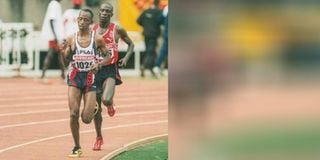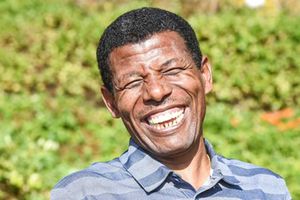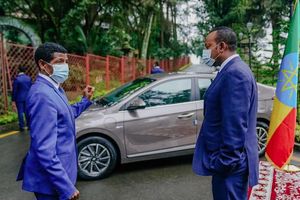
Charles Kamathi leads Moses Mosop in the men's 10,000m at the Kenya trials for the 2005 Helsinki World Championship at the Moi International Sprots Centre, Kasarani on July 26, 2004.
Once upon a time, there lived a great Ethiopian runner named Haile Gebrselassie, the “Emperor of Distance Running”. He broke 61 Ethiopian records from the 800 metres to the marathon and set 27 world records.
He tormented Kenyans at every level of competition for a decade until one fine, cool night in Edmonton, Canada, 23 years ago when he was smoked out of town by a young Kenyan rookie named Charles Waweru Kamathi.
Kamathi also surprised everybody after going to the 2001 World Athletics Championships in Edmonton with a missing incisor on his upper jaw but returned home with a complete dental makeover courtesy of a Canadian dentist impressed by his historic victory.
Gerbselassie started his long journey to greatness in the 1992 World Junior Championships in Seoul, South Korea when he beat Josephat Machuka in a controversial final at the 10,000 metres.
The next year in Stuttgart, Germany, Gerbselassie won his first of four straight world titles and two Olympic gold medals in the 10,000m metres.
His first Olympic victory in the 1996 Atlanta Centenary Games earned him the lead acting role in the Hollywood production movie “Endurance” released in 1999.
Gebrselassie slowed down
From then onwards, Kenyans and the world resigned to the fate of waiting until Gebrselassie slowed down, which at the turn of the last century and new millennium appeared as a far-fetched figment of the imagination.
Then on August 8, 2001, in Canada shortly before 10:30 local time (6:30am Kenya time), Kamathi pulled off one of the most dramatic victories and upsets in modern athletics by bringing to a halt Gebrselassie's 37 major races winning streak with victory on the men’s 10,000m final.
"I still have dreams of that race," said Kamathi, 46, and now an Inspector of Police at Nyeri Police Station.
He was 23 then and the victory still brings goose bumps for Kenyan athletics fans who have watched videos of the race time and again.
"Haile didn't know what hit him," recalled Kamathi, the last Kenyan to win the 10,000m at the world championships from his base in Nyeri.
"I don't run any more after being forced to retire by a hamstring injury. I chase criminals now.
"I had seen Haile in action in many races. He was a subject of discussion in every athletics forum even at the village during the games. I knew him well. He knew very little about me."
So, on that fateful evening, as they boarded the bus for the 50,000-capacity Commonwealth Stadium, the three Kenyans -- Kamathi, John Korir and Paul Kosgei -- didn't have any burden of expectations, unlike Paul Tergat who had duelled with the Ethiopian in four Olympic Games and two Olympic Games, and come second best.
Indeed, Edmonton was the perfect setting with its unique culture -- laid back with proud people who never shy away from praising their cattle and succulent beef cut marketed under the famous slogan, "If it Ain't Alberta, It Ain't Beef."
But that day Canadians were not thinking about beef. They gathered to come watch the great Gebrselassie, appearing on Canadian soil for the first time and used by the World Athletics, then the International Association of Athletics Federations (IAAF), as the face of the championships alongside American disgraced sprinter Marion Jones, then the hottest athlete in the world.
In Edmonton, the Ethiopian was received like a visiting rock music star in a country which had remained without an athletics hero since Ben Johnson failed a performance-enhancing drug test at the end of the men’s 100m in the 1988 Seoul Olympics.
Canadians had become accustomed to watching athletics on TV. But now the world was at their feet, and they were determined to show appreciation by turning up in large numbers at the stadium.
Abera Gezahegne had opened the championships with a gold medal in the men’s marathon where Kenya’s Simon Biwott finished third behind Italian Stefano Baldini.
Was the men’s 10,000m going to be a repeat of the last 10 years --- Kenyans running second fiddle to the master Gebrselassie?
The daily programme in Edmonton proceeded without drama until the sixth day when Kenyans were lined up for two finals of the day -- the men’s 3,000m steeplechase and men’s 10,000m.
This would be the night of champions. The buzz was palpable.
"I was comfortable because nobody gave me much attention. I had finished third in the World Cross Country Championships, and second in Hengelo, Netherlands Grand Prix on May 24 in the 10,000m behind Ethiopian Assefa Mezgebu. I had never been in the same race with Haile."
Finished fifth
"It was a complete makeover for us," recalled then national head coach Dan Muchoki. "Tergat had retired from the track the previous year to launch his marathon career. Only John Korir was known to the Ethiopians having finished fifth in the Sydney Olympics at the 10,000m, and the other good athlete Patrick Ivuti, fourth in Sydney, was missing.”
But as the race time approached, there was optimism in the Kenyan camp.
This being the sixth day of competition, Kenyans living in Canada, mostly students and the generation of Asians from Kenya and Uganda who immigrated to Canada in the past millennium, came out in full force, dressed in Kenyan colours.
They sang themselves hoarse, their drums drowning all voices at the stadium as they created an electrifying atmosphere.
Paul Kosgei sent Kenyans into a delirium of joy after winning the 3,000m steeplechase gold and doing a lap of honour accompanied by bronze medallist Barnard Barmasai.
"I watched the whole race at the warm-up, and this gave me strength and the challenge to run my best," said Kamathi.
Noise on the Kenyan corner hit a crescendo, as they sang the then-popular Malika song... “wape, wape vidonge vyao.... wakimeza wakitema in shauri yao”.
It was a carnival atmosphere that never ended until the men’s 10,000m race ended.
The field remained bunched when they received the bell. On cue, Kamathi, placed in fifth position, started covering the lost ground, reeling in one runner after another with every step.
First, Admassu, then Kosgei, Korir and at the 200m he overhauled the fast-fading Gebrselassie, then Mazgebu. There was a look of surprise by the defending champion from the giant screen as Kamathi streaked past.
The Kenyan glanced sideways once, twice before picking up another gear and started pulling away.
At the home stretch, he was already 10 steps ahead and continued with his acceleration as pandemonium broke out in the stands. This was going to be his race.
He lifted his hands, his head held high, eyes closed as he crossed the finish line and closed a chapter in Gebrselassie's checkered history while opening a new one for himself.
Mezgebu out-sprinted Gebrselassie to finish second with Korir fourth and Kosgei fifth.
That evening a lady at the Games Village who had watched the race in amazement looked out for Kamathi for an appointment with a dentist the following day to fix his missing tooth in time for the medal presentation ceremony the following day.
Kamathi was born in Nyeri on May 18 1978.
He started running in 1995 at Esmi Club in Nyahururu.
Athletics agent, the late Sunishi Kobayashi and Athletics Kenya Treasurer David Miano, secured him a scholarship to Japan in 1997 where he joined the Toyota Club.
His stay was short-lived after suffering from tendinitis and he returned home a year later where he reunited with coach Geoffrey Chege who was then with the Kenya Police Service. Chege encouraged him to join the service.
He duly did and was accorded the chance to compete abroad and in local competitions. He was posted in Embu where he rose through the ranks before he was transferred to his current work station in Nyeri.
Even though he is happy to continue chasing criminals he also has thoughts of athletics
“I would like to see the revival of community clubs like ESMI and Mfae in Nyahururu if we are to revive athletics there and in Nyeri.”
He says Kenya Police offered him a job at his hour of need and he is only returning the favour by serving in the service with diligence and love.










